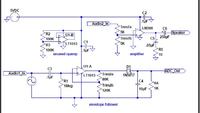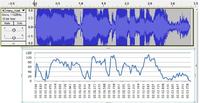djsfantasi
Advanced Member level 4

I am looking for a simple circuit, into which I supply an audio signal, such as from the headphone jack of a PC or CD player. The strength/volume of the signal would then be scaled to 0-5VDC in order to be read by a uP.
The uP is a specialized controller for servos (Lynxmotion SSC-32) and has four built-in analog inputs, with a 5VDC reference voltage. A single byte value is returned, with 0 being 0V and 255 being 4.98V. Unfortunately, the reference voltage cannot be changed, so I want to externally map the audio to this range.
Can anyone help?
Thanks,
dj
[/url]
The uP is a specialized controller for servos (Lynxmotion SSC-32) and has four built-in analog inputs, with a 5VDC reference voltage. A single byte value is returned, with 0 being 0V and 255 being 4.98V. Unfortunately, the reference voltage cannot be changed, so I want to externally map the audio to this range.
Can anyone help?
Thanks,
dj
[/url]





